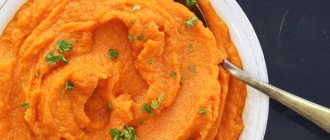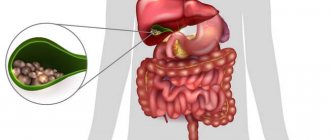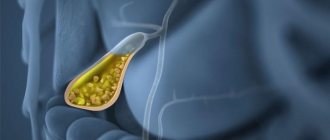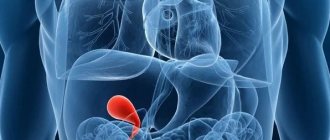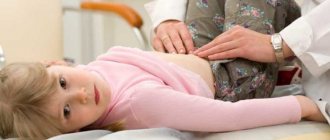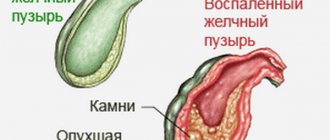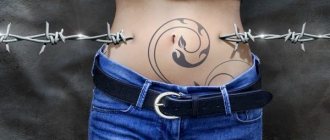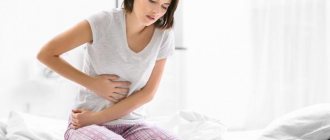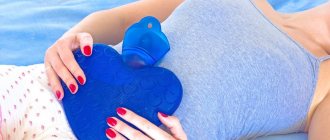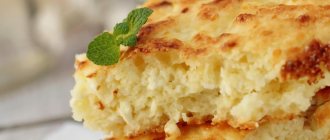Today, low-traumatic and quick surgeries to remove the gallbladder have become widespread throughout the world. However, the consequences of surgery often cause health problems. Patients are often concerned about how to live without a gallbladder.
Below I publish my answers to questions from Healthy Lifestyle correspondent Yulia Kirillova, to whom I told about the peculiarities of restructuring the body, deprived of one of the links of the digestive system, and overcoming the problems associated with it.
What is bad if the gallbladder is removed to rid the body of gallstones?
Of course, getting rid of gallstone disease in the simplest way is the dream of both the patient and the gastroenterologist. But at the same time, it is necessary to provide for all possible consequences of such a step.
After all, even at the stage of preparation for the operation and during its implementation, there is a danger of underestimating many factors. These are diagnostic errors when softer clots of bile - sludge - are mistaken for stones, and removal of the gallbladder without stones at all inevitably entails complications.
The possibility of damage to the bile ducts, which sometimes does not even depend on the skill of the surgeon, may require repeated surgery and long-term rehabilitation. In addition, undetected stones can remain in the ducts and cause acute cholangitis (inflammation of the ducts) and obstructive jaundice.
The bile produced by the liver enters the gallbladder, where it is concentrated, and from there it flows into the duodenum, participating in the digestion of fats and food proteins. Deprived as a result of cholecystectomy - an operation to eliminate the natural storage of bile (gallbladder) with stones - the regularity of bile movement is disrupted. And now bile is involved not only in digestion, but can be thrown into the stomach, burning the mucous membrane, threatening gastritis, esophagitis, and biliary diarrhea.
Anatomical changes are followed by biochemical ones. And functional disruptions of the gastrointestinal tract are the most common.
https://youtu.be/8nkzoHRkD2Q
Diet
The patient’s nutrition is one of the main factors that allows not only to alleviate the patient’s condition and shorten the rehabilitation period, but also to help the body adapt to new living conditions. Since, despite the absence of a gallbladder, the liver continues to produce bile, which begins to flow haphazardly into the duodenum, it is necessary to adhere to some dietary restrictions aimed at reducing the intensity of bile production and optimizing the digestive process. In the postoperative period, the diet should consist of semi-liquid pureed food that does not contain fats, spices and coarse fiber, for example, low-fat fermented milk products (cottage cheese, kefir, yogurt), boiled pureed meat, pureed boiled vegetables (potatoes, carrots). You should not eat marinades, smoked meats and legumes (peas, beans), regardless of the cooking method. In addition to the question of what you can eat, how often should you eat is of great importance? Increasing the frequency of meals will normalize the digestive process and adapt it to new conditions. Thus, eating small portions of food 5–7 times will avoid the liver’s response to the appearance of a large food bolus in the stomach, and bile production will remain within normal limits. From the 3rd–4th postoperative day, you can switch to a normal diet, adhering to the diet and frequency of meals provided in dietary table No. 5.
Tell us more about these violations
The formation and excretion of bile occurs in new anatomical conditions. Adaptation to them in case of a successful operation takes about a year.
But often after surgery, pre-existing diseases (duodenitis, ulcers, reflux esophagitis, irritable bowel syndrome) and chronic biliary pancreatitis - a condition of the pancreas that suffers most from the presence of stones and dysfunction in the gallbladder - become aggravated.
Due to the loss of the cystic reservoir, bile produced by the liver in large quantities (up to 1.5 liters per day) immediately enters the ducts. The pressure in them increases, inflammation occurs, and with it pain and dyspepsia (diarrhea). In addition, the tone of the sphincter of Oddi, a smooth circular muscle that controls the flow of bile into the duodenum, is pathologically increased. In a word, consider chronic pancreatitis, and with it - a violation of the enzymatic activity of the pancreas, food digestion and metabolism.
Symptoms of cholecystitis
If you suddenly notice the following signs, you should urgently seek medical help:
- sharp pain in the right hypochondrium,
- bitter taste in the mouth,
- nausea, vomiting,
- bloating,
- constant burning in the sternum, heartburn,
- yellowness of the skin and mucous membranes.
If you feel acute pain when palpating your right side, you should immediately consult a doctor. Many doctors recommend that if stones are found in the bladder, it is better to remove the organ completely. Of course, you can prescribe drug therapy, but this is for the time being.
And how do you propose to escape from all these troubles?
The thing is that removing the gallbladder does not protect against the appearance of new stones, i.e. cholelithiasis persists. After all, the liver continues to produce the same “stone-forming” bile. And the regulators of bile flow - the system of bile ducts and sphincters - can detect their insufficiency with spasms and painful attacks in the abdomen.
In this case, within 1-3-6 months it is necessary to carry out:
- biochemical blood tests to determine blood sugar,
- X-ray or gastroscopy of the stomach (according to indications),
- Ultrasound of the pancreas and bile ducts,
- scatological analysis of stool (for digestion of food),
- modern laboratory study of pancreatic elastase in feces. The simplest diagnostic test developed by domestic scientists from the Faculty of Biology of Moscow State University indicates pancreatic enzymatic insufficiency (less than 200 mcg) and requires long-term enzyme replacement therapy.
How does pregnancy proceed after cholecystectomy?
Many patients live fully without a gallbladder. But the absence of a digestive organ in women can complicate pregnancy. Therefore, when planning a child, you should consider some features:
- The absence of a gallbladder can cause itchy skin and an increase in the level of bile acids in the bloodstream;
- During pregnancy, the liver will be displaced and the intrahepatic ducts will be compressed, which causes increased formation of stones;
- To prevent the occurrence of jaundice in a newborn baby, a woman will need to regularly take antihistamines, multivitamins, and antioxidants;
- A decrease in the patient’s physical activity in the third trimester will contribute to congestion.
It is important to understand that cholecystectomy is not a direct contraindication to pregnancy. After surgery, a woman is able to carry and give birth to a healthy child, but she must be under the constant supervision of specialists
This will help prevent stagnation of food secretions and reduce the risk of symptoms of jaundice.
How can the operational consequences be corrected?
If the operation was successful and there are no chronic gastrointestinal diseases, then specific treatment after removal of the gallbladder is not necessary.
To prevent bile from stagnating in the ducts, it is enough to eat regularly, in small portions, drink enough clean water between meals, and periodically brew rose hips as tea.
You need to eat a little, but often (6-7 times a day), not forgetting that each meal contributes to the active release of bile into the duodenum. A gentle diet with boiled, pureed dishes is recommended only in the first month after surgery with a limitation (but not exclusion!) of fats. A return to a normal diet should occur within 3-6 months. This is the key to successful adaptation. A complete diet includes a sufficient amount of proteins (meat, fish, cheese, cottage cheese) and carbohydrates (white bread, cereals, fruits, vegetables).
Fiber-rich salads are very healthy. For example, the simplest: from shredded and squeezed cabbage and tomatoes (1:1) or coarsely grated carrots and turnips (equal parts) with the addition of lettuce, seasoned with sour cream or vegetable oil.
An excellent help for normalizing stool and improving the quality of bile is adding wheat bran to any dish. They can also be taken separately, pour 200 g of boiling water into 2-3 tablespoons, let it brew for at least 2 hours (or overnight) and take it - first 1 teaspoon at each meal, with water or adding them to food.
Small meals should be combined with frequent drinking of clean water. Between meals you should drink a glass of water. Gastroenterologists do not have a consensus regarding mineral water. I believe that low-mineralized non-carbonated alkaline water (like Belinska Kiselka from Slavakia, Donat from Slovenia, Slavyanovskaya, Borjomi, Essentuki No. 4 in a 20-day course 6 months after the operation) will not hurt.
Preparation for the procedure
In the vast majority of cases, gallstone laparoscopy is a planned intervention. In order to identify possible contraindications and the general condition of the body in advance, 14 days before the procedure the patient undergoes an examination and submits a list of tests:
- physical examination by a surgeon;
- visiting a dentist, therapist;
- general analysis of urine and blood;
- blood biochemistry with the establishment of a number of indicators (bilirubin, sugar, total and C-reactive protein, alkaline phosphatase);
- establishing the exact blood type, Rh factor;
- blood for HIV and Wasserman reaction, hepatitis viruses;
- hemostasiogram identifying activated partial thromboplastin time, thrombosed time and index, fibrinogen;
- fluorography;
- Ultrasound;
- retrograde cholangiopancreatography;
- electrocardiography;
- for women - vaginal smear for microflora.
An operation to remove the gallbladder using the laparoscopic method will be carried out only if the results of the above tests correspond to the norm. If there are deviations, the patient will need to undergo a course of treatment to eliminate the identified violations. If the patient has pathologies of the respiratory and digestive systems, in consultation with the operating doctor, a course of drug therapy is possible to eliminate negative symptoms and stabilize the condition.
Preparation for laparoscopy of the gallbladder in the inpatient department includes a number of sequential activities:
- on the eve of surgery, the patient’s diet should consist of easily digestible food, the last meal is dinner at 19-00, after which you cannot take any food; after 22-00 it is forbidden to drink liquids, including water;
- on the day when the operation is scheduled, eating food and liquid is prohibited;
- in order to cleanse the intestines, it is necessary to do cleansing enemas - the evening before the intervention and in the morning; for greater effectiveness, it is possible to take laxatives 24 hours before surgery;
- In the morning you need to carry out hygiene procedures - take a shower, use a razor to remove hair on your stomach.
On the eve of the operation, doctors - a surgeon and an anesthesiologist - have a conversation with the patient, during which they talk about the upcoming intervention, anesthesia, possible risks and negative consequences. The conversation is conducted in a consultation form - the patient can ask questions of interest. Afterwards, the patient gives written consent to the intervention and the use of anesthesia.
https://youtu.be/3xoVkacYJ_U
What can you say about medications?
The most common prescription is ursodeoxycholic acid, which improves the quality of bile and the functioning of liver cells (250-500 mg at night). Chenotherapy (“heno” means bile) – treatment of animals and birds with bile acids usually involves the use of Ursosan and Ursofalk; the domestic drug Enterosan has a positive effect .
To bind excess bile in the intestinal tract (especially with diarrhea), sorbents are usually prescribed - activated carbon (5-10 tablets per night), smecta (1 sachet 1-3 times a day), Gaviscon, as well as those with sorbing properties that neutralize hydrochloric acid. acid antacids Maalox, Almagel, Phosphalugel. A universal sorbent is flax seed. The daily norm is 1-2 teaspoons per glass of hot water for laxity and 3-4 teaspoons for stool retention, kept for about 8-10 hours.
With spasms of the smooth muscles of the sphincter of Oddi, a person is haunted by pain. The problem of relaxation is solved with the help of antispasmodics. Duspatalin (200 mg 2 times a day for 10 days) and Dicetel (1 tablet 3 times a day for 3-6 weeks, Odeston 1 tablet 3 times a day before meals) have proven themselves well in this regard. mild choleretic).
When diarrhea, flatulence, or constipation occur, which is often accompanied by a violation of the intestinal microflora, intestinal antipeptics are prescribed (Intetrix or Ercefuril 1 capsule 3 times a day after meals for 5-7 days, Furazalidone (1 tablet 3-4 times after meals for 10 days ), Biseptol.
If treatment requires anti-inflammatory and antispasmodic drugs at the same time, use the healing power of plants. Let's say 3 tbsp. spoons of chamomile flowers are brewed with 0.5 liters of boiling water and, after standing for 15 minutes in a water bath, drink 1/3 cup 3 times a day with the addition of a couple of tbsp. spoons of honey.
Do you need to limit yourself to food for the rest of your life?
Russian manuals for doctors tell you to eat according to “table number 5” throughout your life, while foreign ones say that in the absence of complaints, a diet is not needed. But this does not mean that you should eat exclusively burgers: we are talking about a varied diet, which includes vegetables, fruits, carbohydrates, and fats. For example, read the article about what you can eat if you have liver disease.
Here's what our expert, gastroenterologist-hepatologist Ekaterina Kashukh says about this:
Modern dietary guidelines come to the ineffectiveness of long-term diets and the concept of “correction of eating behavior.” My patients after cholecystectomy, among those who eat whatever they want within reasonable limits, and among those who sacredly honor table 5, have the same number of problems with the gastrointestinal tract. Only the first ones look happier. Expert of the site pokhover.rf Ekaterina Kashukh
expert of the site pokhmelye.rf Ekaterina Kashukh
It seems it's time to talk about herbal remedies
There are a great many of them and not only pharmaceutical ones, such as choleretic teas, rose hip syrup, corn silk extract, but especially recipes from herbalists and traditional healers.
For indigestion:
Bird cherry berries (3 parts) and blueberries (2 parts) rich in dietary fiber help with relaxation. Fill for 20 minutes 2 tbsp. spoons of a mixture of sorbents with an astringent taste, drink ¼ cup of the infusion on an empty stomach in the morning and between meals. A 30-minute infusion of 2 teaspoons of alder fruit (2 parts) and serpentine rhizome (1 part), poured with a glass of boiling water, has a similar effect. This portion is drunk in three doses.
For persistent constipation:
Before and after the operation, jam from 300 g of dried apricots, prunes, figs minced through a meat grinder with the addition of Alexandria hay leaf (50 g) and honey (200 g) helps. Eat 1 teaspoon of jam at dinner or 1-3 times during the day with tea or water.
Anesthetic and sorbent collection:
In my many years of practice, for all disorders associated with the elimination of the gallbladder, I usually prescribe an optimally composed and very effective collection of the Vladimir herbalist S.I. Mikhalchenko. It includes plants with analgesic and sorbing properties - burdock roots, sage and plantain leaves, blueberry shoots, knotweed herbs, mint, string and St. John's wort, calendula and chamomile flowers. Take equally - 50-100g. Pour 1 dessert spoon (10 g) of the mixture into 0.5 liters of boiling water in a thermos overnight, and then strain the infusion, take 150 ml an hour before meals 2-3 times a day. Store the drug in the refrigerator and warm it up before use by adding hot water. The course is 3-4 months, 10 days on and 2 days off.
For pancreatitis:
In case of a complication in the form of pancreatitis - a faithful companion of cholelithiasis, I prescribe Mikhalchenko's collection, containing herbs with anti-inflammatory and antispasmodic effects (chamomile, calendula, string, St. John's wort, plantain, St. John's wort), sorbent and astringent properties (blueberry, sage). It contains chamomile and calendula inflorescences, string herbs, St. John's wort, knotweed, sage and plantain leaves, blueberry shoots, burdock roots. Pour 1 dessert spoon of the mixture into 0.5 liters of boiling water in a thermos overnight, then drink 150 ml 3 times a day an hour before meals for 10 days. After a two-day break, continue the course for 1 to 3 months. Store the infusion in the refrigerator.
Choleretic collection:
But you need to be careful with choleretic mixtures and herbs. Of interest is the common barberry, which has a choleretic, anti-inflammatory, analgesic, antispasmodic effect and is used for cholelithiasis and urolithiasis, postcholecystectomy syndrome, and chronic pancreatitis. Preparations: Infusion of barberry leaves 10 g per 200 ml of hot water, close the lid and heat in a boiling water bath for 15 minutes, cool for 45 minutes at room temperature, squeeze out the remaining raw materials. The volume of the resulting infusion is adjusted to 200 ml with boiled water. Reception: 1 tablespoon 3-4 times a day 15 minutes before meals for a month, break 2 weeks, possible repeat course (up to 3-4 months) . Berberine bisulfate in tablets of 0.005 g 2-3 times a day before meals for a month. Repeat the course after a 10-day break. There are no contraindications. After the main course, no more than 2 courses.
How to live without a gallbladder, is physical activity possible?
A month and a half after the operation, it’s time to start exercising. It is best to start with walking; 30-40 minutes of walking in the fresh air prevents bile stagnation and improves oxygen saturation of the body. And after a few days you can do light exercises. After 2-3 minutes of walking, perform the exercises in a lying or standing position, repeating 4-6 times.
- Lying on your back, legs straight, arms along the body. As you exhale, bend your leg, bringing it as close to your stomach as possible, and while inhaling, straighten it. Also with the other foot.
- Lying on your back, hands on your belt, as you exhale, lift and move your straight leg to the side, while inhaling, lower it. Also with the other foot.
- Lying on your back, legs bent, arms along your body. As you inhale, slide your heels along the floor, slowly stretch your legs, and as you exhale, bend them just as slowly.
- Lying on your side, legs straight, one hand on your belt, the other behind your head. As you exhale, bend the leg lying on top, and while inhaling, straighten it. Do the same by turning to the other side.
- Standing, feet shoulder-width apart, hands to shoulders, make circular movements with your elbows 8-10 times forward and back. Breathing is voluntary.
- Standing, feet shoulder-width apart, hands on your belt. As you inhale, move your elbows back, and as you exhale, return to the starting position. 6-8 times. Or turn your body left and right, spreading your arms to the sides.
Bends, lifting the legs and body from a lying position, and other abdominal exercises are allowed no earlier than six months after the operation and if you are in good health. And heavy physical activity, especially associated with tension in the abdominal muscles, can be done only after a year in order to avoid the formation of a postoperative hernia.
Ask questions about the article in the comments; if you want to contact me personally and confidentially, click the “Ask a Question” button at the top. Initial consultation is free.
Health to you, dear readers!
Advantages and disadvantages of laparoscopy
Compared to traditional surgical techniques, laparoscopy has a number of undoubted advantages, namely:
- this technique does not involve an incision in the abdominal cavity, since the instruments are inserted through several small punctures (no more than one centimeter in diameter);
- the risk of possible negative consequences after such an intervention is minimal;
- already on the third or fourth day the operated patient is discharged from the hospital;
- small size of surgical wounds;
- after laparoscopy, the patient does not experience severe pain, as a result of which there is no need to use strong narcotic painkillers;
- The rehabilitation period lasts two weeks, whereas after abdominal surgery this period can last for two months.
Like any other surgical technique, laparoscopy on the gallbladder has its drawbacks.
Firstly, this technique is contraindicated in some cases when removing the gallbladder.
This operation is not performed on patients with respiratory problems.
Also, laparoscopy is not done if:
- pathologies of the cardiovascular system;
- disturbances in the normal functioning of the lungs and heart;
- pregnancy (last trimester);
- for bleeding disorders;
- overweight.
Before prescribing laparoscopy, the patient should undergo a thorough examination, the purpose of which is to identify possible contraindications, the harm of ignoring which outweighs the benefits of the surgical intervention.
